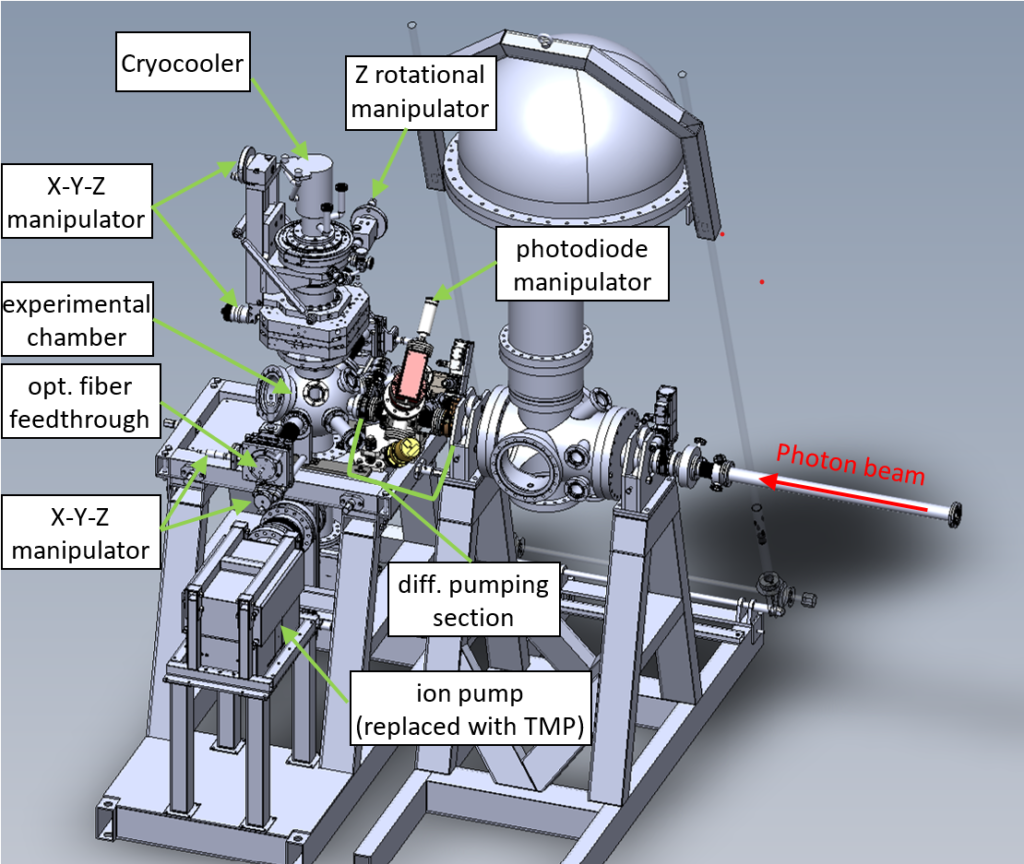The main goal of the photoluminescence end station (PLES) is luminescence spectroscopy research under vacuum ultraviolet (VUV) as well as soft X-rays (XUV) excitations. Any materials in solid phase (single crystals, glasses, ceramics, films, powders, etc.) can be studied. The end station is equipped with a closed-cycle helium cryostat with a cold-finger type sample holder, which provides sample temperatures T = 10 – 300 K. The emission from the sample is collected by optical fiber coupled to Andor Shamrock 0.3 m spectrometer equipped with the CCD camera and several photomultiplier photodetectors, which provide possibility to analyze the emission in the range from UV to near IR. In addition to the photoluminescence spectroscopy, the end station can be applied to optical spectroscopy experiments examining the reflection signal from flat samples’ surfaces as well as detecting the transmitted light passing through the samples studied. Advanced experiments which include a combination of synchrotron light and some external light sources (for a pump-probe and a photostimulated spectroscopy) could be available also if external light sources are provided by users.

Experimental possibilities:
- Emission spectra from UV to NIR spectral range (200 – 1350 nm).
- Excitation and absorption spectra with high resolution in 4.5 -1300 eV spectral range.
- Reflectance in 4.5 -45 eV spectral range.
- Temperature dependence of optical and luminescence properties down to liquid helium temperature (10 K).
Spectrometer:
Andor Shamrock (SR-303i) 0.3 m spectrometer equipped with three gratings (300 l/mm) optimized for different spectral regions (300, 500 and 1200 nm blaze, respectively). The Andor Shamrock spectrometer collects luminescence from samples with the aid of a fiber optic cable.
Luminescence detectors:
- The Newton CCD camera (Newton DU970P-BVF model from Andor) is suitable for the spectral range of 200-1100 nm.
- The set of Hamamatsu photomultipliers (H8259, H8259-01, and H8259-02 photon counting heads) is intended for the spectral range of 200-900 nm.
- The thermoelectrically cooled infrared NIR PMT Unit H10330B-45 (Hamamatsu) can be used in the spectral range of 950-1350 nm.
- The thermoelectrically cooled hybrid photodetector HPM-100-07C (Becker & Hickl) for time-resolved measurements can be used in the spectral range of 220-850 nm. FWHM of instrument response function is 200 ps in single-bunch operation.
Reflection and transmission detectors:
- The AXUV-100G photodiode can be installed for absorption measurements.
- Sodium salicylate-covered window with attached photomultiplier detector is used for reflectance measurements.
Low temperature set-up:
The closed-cycle helium cryostat consists of the ARS DE-204PB cryohead and the ARS-4HW compressor (Advanced Research System). The LakeShore 335 temperature controller allows one to regulate sample temperature in the region of 10 – 300 K.
Sample environment:
The cryostat, mounted on a rotational stage, is installed on an XYZ manipulator (Thermionics) facilitating the alignment of the sample with respect to the incident beam. The size (20×90 mm2) of the two-sided sample holder is large enough to accommodate even dozens of samples on each side. The UHV vacuum chamber is evacuated to the working vacuum level of 10-9 mbar at room temperature by a turbo pump HiPace 300 (Pfeiffer Vacuum).
Time-resolved measurements and single-bunch operation
The experimental setup is equipped with a fast detector for time-resolved measurements. In usual operation conditions, the bunch length is ~700 ps and the time window between the bunches is 10 ns. To increase the time window and shorten the excitation pulse duration, single-bunch operation mode of the ring can be requested. In that mode, the bunch length is ~200 ps and time window is 320 ns.
A whole week of single-bunch (SB) operation will be available to users in each semester. If you want to apply for a beamtime in a single-bunch week, you should indicate that clearly in your beamtime proposal. In that case, the scientific motivation of your proposal should be based on the use of single-bunch operation.
It might also be possible to arrange some SB shifts outside of the SB week if other beamlines at the 1.5 GeV ring agree with it. If you are interested in such a possibility, please check the corresponding box under the selection of the photoluminescence end station during the proposal submission in DUO and motivate your need of single-bunch operation in the proposal. The availability of this extra single-bunch operation cannot be guaranteed.